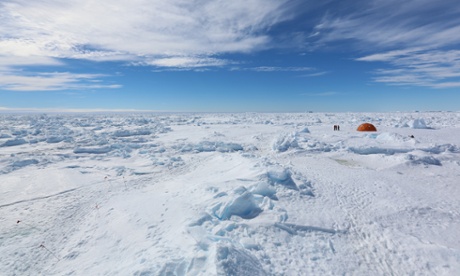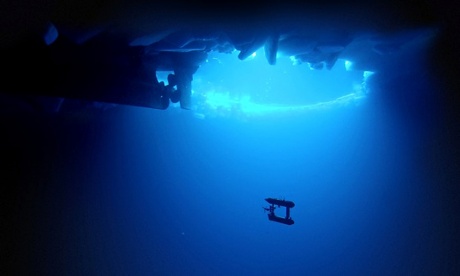Antarctica is the Earth’s last pristine, untouched and most epic wilderness. A key area for the world’s climate and wildlife, it is, for now, also a place of unparalleled international co-operation and negligible commercial exploitation. It has enjoyed more than a century of peace, since explorers first discovered it.
But the Antarctic is also a place of great danger, a remote location where humans are almost never in control, where nature’s rule is absolute. On Friday, making exploration of this part of the world safer is high on the agenda of the International Maritime Organisation (IMO). Its members will come together to discuss the adoption of a polar code to ensure that expeditions to the extremities of the world abide by a set of technical and operational standards.
Fresh in the minds of those attending will be the stranding of the MV Akademik Shokalskiy, a Russian research vessel that was trapped in the ice off East Antarctica for 10 days over Christmas and the new year, with more than 70 people on board, while operating an expedition for the Australasian Antarctic Expedition (AAE). A series of icebreakers tried, and failed, to break a path to free the stricken ship and this international rescue effort – five nations working together amid the harshest conditions in one of the most isolated areas on Earth – caught the world’s attention. The story led TV news bulletins and filled newspaper front pages.
The Akademik Shokalskiy incident has exposed differences in the scientific community; some researchers criticised the expedition as a glorified tourist trip that had seriously dented real scientific research in the region. The event also highlighted gaps in how expeditions to the Antarctic are permitted by national authorities.
At the heart of all the discussions are fundamental questions about who owns access to Antarctica and what activities should be allowed there, now and in the future.
Research programmes in the Antarctic are mostly controlled and supported by government-funded agencies, such as the Australian Antarctic Division (AAD) and the British Antarctic Survey, which also maintain a network of permanent bases around the continent. But the summer AAE trip that the Guardian joined was not a typical scientific expedition to the polar region.
The Akademik Shokalskiy had 22 crew and 52 passengers, half of the latter group being scientists, the other half members of the public who had paid to go on the trip as science assistants. The AAE, led by Chris Turney, a climate scientist at the University of New South Wales, was funded from private sources, including the passengers on board, and the science case was built up and reviewed, over several years, by Turney and colleagues at UNSW.
Though the AAD assessed the environmental impact of Turney’s expedition, it had no role in funding or assessing its scientific goals. A century on from the first AAE, on which the British-Australian explorer and scientist Douglas Mawson visited and mapped large parts of East Antarctica for the first time, the new expedition aimed to record how this part of the world had changed in 100 years.
The private funding model is not a new one. During the heroic era of Antarctic exploration, led by Scott, Shackleton, Amundsen, Mawson and others, much of the money came from patrons. They also engaged public attention in newspapers and with images and films, to raise the money to explore the then unknown south.
But time has moved on from the era of the great explorers: the roots of the modern Antarctic era began half a century after the expeditions of Scott and Mawson. In 1957-58, scientists held the International Geophysical Year, the first serious effort to carry out a concerted programme of research on the continent. That led, in 1961, to the Antarctic Treaty – signed by 12 nations at first but now more than 50 – under which countries agreed to use the Antarctic regions only for peaceful and scientific purposes.
There were, and still are, territorial claims to the continent – from the UK, Argentina and Australia, among others – but none is officially recognised by the international community. In 1991, with the Madrid Protocol, the treaty expanded to include a ban on mining for minerals on the continent. Treaties, however, do not last forever. Nations are already positioning themselves for the long term, when they will be able to do much more on the continent than just scientific research.
Nowadays, scientists carry out a vast array of work, relating to everything from climate change and ecology to cosmology, on and around the bases in Antarctica. This part of the world is important, for example, in understanding how the climate will change over the next century – around its coasts are the engines for many of the world’s ocean currents and there is enough ice sitting on the continent to add 60 metres to global sea levels, if it all melted.
“Along the [West] Antarctic peninsula, it’s one of the regions that’s warming quickest on the planet and there’s potential for a few metres of sea level there,” said Mike Sparrow, executive director of the Scientific Committee on Antarctic Research.
Countries have maintained a permanent presence in Antarctica during the past half-century by building bases, in what is arguably the last colonial scramble on Earth. The US has six bases scattered around the continent, including one at the south pole. The UK has two bases, Australia has three and China has four. Maintaining a presence in Antarctica is a bit like having a space programme – it shows that a country is technologically advanced and can project economic and political influence.
But carrying out work safely in this remote part of the world requires a rigorous planning and logistical operation. At the British Antarctic Survey, which is typical of many national Antarctic programmes, most scientific projects have a lead time of at least two years. Major projects involving several countries and many Antarctic locations could take five or six years of planning. Even the annual resupply of the main British bases, Rothera and Halley, is so logisitically complex that it requires ships to leave the UK in the autumn.
The James Clark Ross, primarily a scientific research vessel, leaves around September every year and the Ernest Shackleton, used mainly for cargo, leaves in November. “Both ships are full to the gunnels with fuel, food, cargo, scientific equipment,” said John Shears, head of operations and engineering at BAS. “We try and ship everything we need for all the stations and scientific field parties in the two ships.” By the beginning of April, which marks the end of the annual Antarctic summer season, the ships will have unloaded their cargo, finished their scientific work and begun the long journey back to the UK.
This resupply and work cycle is carefully planned and even slight disruptions, such as having to divert to rescue a ship in distress, can be a big problem. “It’s very intimately linked – operations, logistics and science programmes,” said Tony Fleming, director of the Australian Antarctic Division. “The ripple effect of any delay will magnify throughout the season.”
The Akademik Shokalskiy got stuck in sea ice just over two weeks into its month-long voyage. After leaving the Antarctic coast on the evening of 23 December, the ship’s captain, Igor Kiselev, found his vessel surrounded by thick pack ice. It was far too dense for the ship to break through and, as the authorities would discover in the coming days, also too dense for even bigger icebreakers.
Kiselev issued a distress call on Christmas Day and the subsequent rescue effort, co-ordinated by the Australian Maritime Safety Authority in Canberra, involved diverting icebreakers from the Chinese, French and Australian Antarctic programmes. After almost two weeks stuck in the ice, the ship’s passengers were evacuated by the Chinese icebreaker Xue Long’s helicopter, to the Australian icebreaker Aurora Australis.
In the days after the rescue, many scientists criticised the AAE and its leaders for the impact they had had on the scientific research programmes of the nations that had gone to help them. Yves Frenot, director of the French Polar Institute, told Agence France-Presse that sending the French icebreaker L’Astrolabe to assist in the early stages had caused his scientists to scrap a two-week programme of oceanographic research. “But we are relatively lucky,” he said. “The Chinese have had to cancel all their scientific programme, and my counterpart in Australia is spitting tacks with anger, because their entire summer has been wiped out.”
The Aurora Australis was called to Commonwealth Bay to rescue the Akademik Shokalskiy’s passengers when it was halfway through the resupply of the Australian Antarctic base, Casey. “There was a programme looking at remediating soil [near Casey], so working on taking contaminants, historic contaminants out of the soil,” said Nick Gales, AAD’s chief scientist. “Another project looking at the effects of carbon dioxide on the animals and plants that live on the coastal ocean floor, and another project that looked at collecting the hydrography around the area, were all affected to various degrees by the delay.”
None of the critics of the AAE had any issues with the rescue itself – it is a principle of the law of the sea for ships to aid each other in times of distress.
“My personal feeling was that [the criticism] was perhaps because there was feeling that the [AAE] was claiming to be primarily a scientific expedition and I think that probably put some people’s noses out, particularly perhaps the Australian Antarctic Division,” Sparrow said.
Turney disputed the repeated claim that the AAE was not a scientific expedition. “Half the team were fulltime scientists, looking at the full range of natural and physical sciences, and they were going to be doing work almost from day one,” he said.
He pointed to a 40-hour series of observations of temperature and saltiness of the Southern Ocean, using hi-tech probes, around the Antarctic convergence – where the tropical seas give way to polar waters – made by oceanographers on the AAE. “That’s an amazing experiment – no one had actually done that in the Southern Ocean before, crossing a major ocean boundary.”
In the short term, arguments over whether or not the AAE was a scientific expedition will be settled by its outputs. Longer term, persuading the scientific community that projects not funded by national agencies can still do good science could be a long, uphill struggle.
On the logistical side, international authorities have also been rehearsing their thoughts on how to learn from the Akademik Shokalskiy incident. The AAD will issue a report about the rescue at the annual Antarctic Treaty meeting, due to be held in April in Brasilia. The issue under general discussion will be whether or not the permitting systems of different countries are robust enough to avoid incidents, such as the Akademik Shokalskiy’s, having such a big impact on their Antarctic programmes.
The Antarctic Treaty requires all expeditions to be authorised by government authorities but countries differ in how they implement the rules. For example, British citizens, planes or vessels going to Antarctica are assessed on environmental grounds, whether the expedition will be operated safely and if it is properly insured. The Foreign and Commonwealth Office (FCO) adds that the UK examines whether or not a proposed expedition is self-sufficient, not just in terms of food and fuel but whether or not the people can get themselves out of trouble without relying immediately on help from a national Antarctic programme.
In contrast, the Australian system only looks at the environmental impact of a proposed expedition, not an expedition’s safety or self-sufficiency. The configuration of the AAE, which was not part of a national Antarctic programme but also not a tourist trip registered with the International Association of Antarctica Tour Operators (IAATO), was uncommon and it has tested the Australian authorisation system. The FCO said there will be pressure from other countries for Australian authorities to re-examine their procedures in light of the incident.
The Akademik Shokalskiy’s stranding demonstrated that, if something goes wrong on a country’s watch, it could have a significant scientific and financial impact. The AAD’s director, Tony Fleming, estimated the total cost of the rescue to be between A$1.8m and A$2.4m (£960,000-£1.29m) and he and government ministers have said in recent weeks that they will be doing their utmost to recover the money from the AAE and Akademik Shokalskiy’s insurers.
The IMO’s polar code is an important step in improving the safety of Antarctic expeditions. Agreeing new regulations, though, are always a delicate process, due to inevitable international sensitivities. When the Akademik Shokalskiy rescue was first formally discussed by the IMO, at a meeting on ship safety in January, there were rumbles of disagreement (albeit polite) between the Australian and Russian delegations.
The Russian delegation insisted that the Australians’ assessment of the ship’s predicament around Christmas – that there was a serious threat to both humans and the environment – had been too pessimistic. “The vessel was ready for this situation, including its equipment, housing and crew. And as subsequent events showed, almost immediately after the evacuation of passengers the weather changed, and favourable wind blew the ship on their own, without assistance proceeded to sea,” they argued in a statement. The ship broke free of the sea ice a few days after the passengers were evacuated and arrived in New Zealand on 14 January.
Disagreements like this are relatively tame, but they could be a sign of things to come. An increasing number of countries are asserting their presence in Antarctica and jockeying for political and economic power over the Earth’s last great wilderness.
Though the Xue Long got stuck in its attempt to rescue the Akademik Shokalskiy’s passengers, its subsequent helicoper evacuation of those on board was hailed a great success by political leaders back home. China has built up its presence in Antarctica quickly over three decades and shows no sign of slowing down – the Xue Long was on its way this year to scout locations for a new base, its fifth, at Terra Nova Bay, and a second icebreaker, bigger and more powerful than the Xue Long, has already been commissioned. President Xi Jinping is a supporter of exploration at the poles and wants China to be ready to exploit the ecomomic potential of these regions.
The Antarctic Treaty already allows some commercial activity as well as the scientific work – fishing is permitted in certain areas of the Southern Ocean and tourists can also visit the continent, as long as their expeditions are approved by their national Antarctic programmes.
But the rules will not last forever. Disagreements between countries about commercial rights to the continent are bound to increase in future, as the renewal date for the Madrid Protocol, due in 2048, approaches. The UK’s continuing diplomatic tensions with Argentina over the Falkland Islands, for example, are in no small part due to the countries’ overlapping claims to Antarctic territory.
In defiance of the spirit of the Antarctic Treaty, the UK made a submission to the United Nations in 2007 for sovereignty of around 1m sq km (386,000 sq miles) of sea bed off Antarctica; it is too difficult to extract any useful minerals from that area at the moment, but technological innovations and environmental changes due to climate change in the Southern Ocean could make drilling an economically viable activity within a few decades.
“Some fear that countries are subtly working to position themselves for that moment in 2048, when the consultative parties may let go of the Madrid Protocol,” wrote Danny Elias of the Antarctic and Southern Ocean Coalition, an umbrella group for more than 150 NGOs with an interest in the polar region, on the organisation’s blog. “One need only look to China, which has already built four Antarctic research stations and has scouted the construction site for its fifth.”
AAE leader Turney said he had learned lessons but had not been discouraged from working on ways to bring private money to future research expeditions to Antarctica. “The AAE was a science expedition, there were volunteers who had paid to go along. It is a different model of doing things but it would be disappointing for people to turn around and say, unless you’re government-logistically supported and/or government-funded completely, that you can’t do science. That would be a real shame.”
The scientists agreed there would be work to do in persuading the wider scientific community that the research aims of any future private expeditions were robust. Turney’s research team on the AAE was composed of scientists who were long-term researchers on climate research and he said the AAE’s science case had been built carefully. So he was surprised by the criticism from colleagues in the climate science community. To mitigate such criticisms in future, Turney suggess that private expeditions could seek endorsement from an independent scientific panel, perhaps overseen by a learned society, which ran in parallel with their logistical planning.
But whatever the problems of the Akademik Shokalskiy’s expedition, Turney said he believed funding science through public interest had big potential. “If we hadn’t got caught by that sea ice, and that was an extreme event, we’d achieved almost everything we’d set out to do,” he said. “And that’s the frustration because this model potentially works so well. There is an innate interest in Antarctica, and I believe an innate interest in science. And people want the excitement of going to this environment, where they can actually help and work, and I actually think working between the public and the scientists to actually fund research and expeditions is an incredibly exciting way of going forward.”
• This article was amended on 4 March 2014 to correct the attribution of a quote from a member of the Antarctic and Southern Ocean Coalition.











